The best camping stove really depends on how you camp. Are you a group campsite junkie that cooks gourmet game hen for your family and friends, or a solo camper that reheats a can of beans and needs to grill up the catch of the day? Maybe somewhere in the middle.
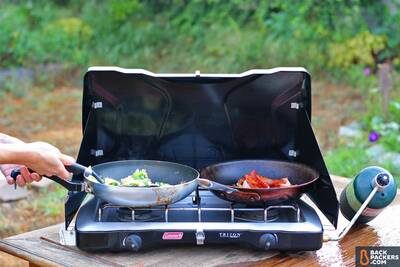
The good news is that there’s a camping stove for you. The comprehensive guide below will lay out the different kind of camping stoves on the market and give you enough context to feel confident about making a purchase. At the very least you’ll learn a few things you didn’t know — at the most, you’ll have an outdoor food revolution.
Navigate with our handy Table of Contents below. You can also read the whole thing. Your call.
Table of Contents:
- Camping vs. Backpacking Stoves
- Stove Types
- Fuel Types
- Stove and Fuel Efficiency
- Wind Resistance
- Features
Camping Stoves vs. Backpacking Stoves
The first thing to consider when buying a stove is activity-based — are you camping or backpacking?
Camping, or car camping, consists of driving to your campsite, parking your car, pitching a tent in the allotted space, and chilling for the weekend (or week if you’re lucky!). The gear for camping is often bulkier, heavier, and engineered for comfort — stoves are no different.
Most camping stoves have two burners, sit on top of a table, use propane, and work equally well at boiling water and making an omelette. Larger camping stoves are standalone and fit to cook truly gourmet meals.
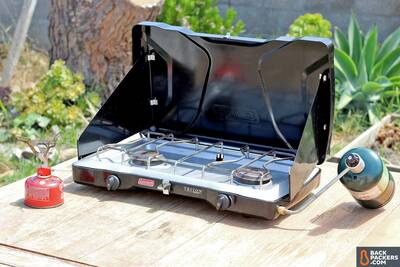
In the middle of the photo is a classic camping stove, the Coleman Triton Series. It has two burners, a built-in windscreen, and is a decent size. On the left is a classic backpacking stove, the MSR Pocket Rocket 2. Notable size difference.
Backpacking, on the other hand, is when you trek into the wilderness with a backpack laden with the gear you need to survive. Backpacking gear is often smaller, lighter, and more specific.
Most backpacking stoves have a single burner, weigh very little, take up almost no room, and thrive at boiling water.
Can You Use a Backpacking Stove for Camping?
If you wanted to get hyper-specific gear for every activity on the planet you could, but that isn’t always necessary. Stoves work relatively well in any environment, so yes, a backpacking stove absolutely works for car camping.
One drawback: You won’t have the same range of cooking ability. Not only are backpacking stoves less stable and smaller than most car camping stoves, but the simmer-ability often pales. This really depends on the stove, but car camping stoves are known for cooking, not just heating up water.
The main difference between the two is one burner versus multiple burners. All backpacking stoves have a single burner. You don’t need more out there. Car camping stoves typically have two burners, or even three in some cases. This allows for multi-task cooking, such as boiling water for coffee while making eggs.
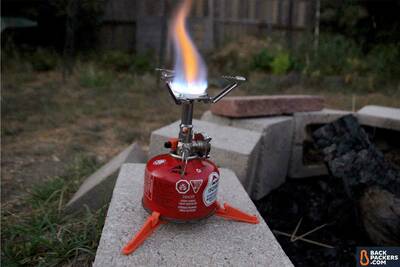
The JetBoil MightyMo is a standard backpacking stove. It rocks, but only has a single burner and much less stability than any camping stove.
The inverse doesn’t really work — almost every camping stove is too big to take backpacking. They are not designed to fit in a backpack, and you’re much better off getting a tiny, relatively inexpensive backpacking stove to take with you in the backcountry.
Camping Stove Types
In the market today there are four major types of car camping stoves. They range from cooking up a single meal of Top Ramen to cooking racks of ribs. (Yeah, you can do that.)
We’ll cover the camping stove types below.
Compact Double Burner Stove
If you’re looking for the classic camping stove, the compact double burner is the one. We reckon these are found in 90% of campsites, though have no official proof for that metric.
The Compact Double Burner has two burners (duh!), two control knobs, opens like a treasure chest, and usually has three-sided wind protection. It’s made for cooking multiple things at once, and hopefully has a decent-enough simmer option to make omelettes and pasta sauces.

The Coleman Triton Series is a classic compact double burner stove.
Number of People Stove Can Cook For: 1-4. Compact double burner stoves can easily handle up to four people. More than that and you’ll want another one.
We could do a full pro/con list, but pretty much everything is a pro for this stove type. That said, there are a lot of features to consider for compact double burners, so keep a few specifics in mind:
- Length of Stove: Not all double burner stoves are made the same. The length of the stove is important, and you’ll want to measure the pots and pans you plan to use to see if they fit side by side. The bigger compact double burners are often the more expensive models, and a wider stove allows a lot more flexibility when cooking. It also means a bigger/heavier stove overall.
- Piezo Ignition: We’ll go into detail about this below, but decide whether or not you want an automatic ignition. This can be super handy, but usually raises the price of the stove by $10-$20.
- Locking Mechanism: Most compact double burner stoves close like a suitcase and lock, thereby protecting the stove’s interior. Make sure this locking mechanism is solid.
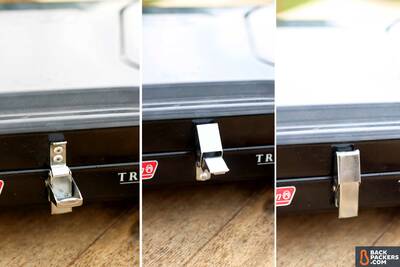
This is a common locking mechanism for a compact double burner stove. Simple and durable.
- Cleanable Drip Tray: All the fancy cooking you’re doing will probably mean a real fancy mess. Stoves that have a removable grill plate are the most convenient, as it allows you clean the drip tray with unfettered access. The drip tray catches all the excess cooking scraps so they don’t get into the burners.
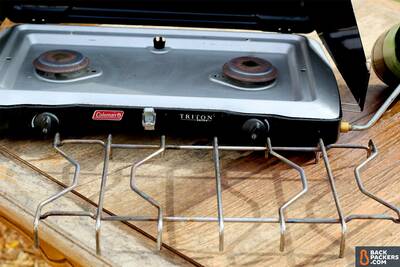
Most compact burners have a top rack that can easily be removed for full access to the drip tray (the silver area under the burners). In some stoves (not this one) you can also remove the whole drip tray to get underneath the burners.
The main Pro of these stoves is that they cook two things at once. Despite how simple that sounds, it’s what most people want when camping.

Compact two burner stoves allow you to do two things at once, like cook fish in tinfoil and boil a pot of water.
We could talk about size and weight as cons, but they are negligible compared to the main pro. Beyond that individual models will come off better as others, which you will see in our testing and reviews.
Tabletop Single Burner Stove
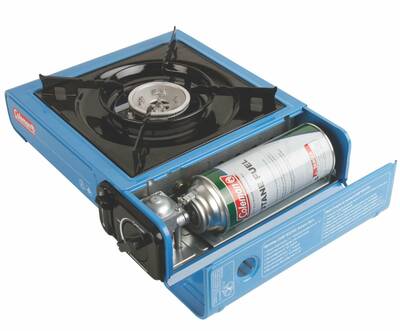
The Coleman Butane Stove is the classic model of a tabletop single burner camping stove.
The most basic car camping stove is the tabletop single burner stove. As the name implies, this has just one burner and sits on a table. There is usually a large burner head with a grill or grate so you can rest a pot or pan easily.
The stove is flat and typically uses butane. These stoves are mostly used by campers that don’t cook much, go out once or twice a year, or just prefer a simple setup. They are also used by people who have a larger stove, and just want one more burner for more complex meals or extra people. They’re a great, cheap option for increasing stove burner capacity without spending a lot of money.
Number of People Stove Can Cook For: 1-2. A single burner is usually suitable for 1-2 people, unless you’re cooking a huge single pot of something, in which case three people is possible.
Pros
- Size and Weight: If you’re concerned about size or weight, consider a tabletop single burner stove. They are relatively small when compared to a compact two burner or freestanding stove, and simple to lug around.
- Easy to Clean: Most tabletop single burner camping stoves have the same form factor, popularized by the Coleman Butane Stove. You simply remove the grate and clean. There are no folding parts or moving pieces, so it’s easy to setup and break down.
- Fits Almost All Pots: Most single burners don’t have wind screens or walls, which is a con, but it also means you can fit pots or pans of almost any size on them.
- Inexpensive: Most tabletop single burners cost around $30, which is less than half the cost of their double burner cousins. They lack a few things, but price is hard to argue with.
Cons
- Just One Burner: It may be obvious, but a single burner means no ability to cook two things at once. Boiling water while cooking breakfast is what most people do in the morning, which is why these stoves are less popular.
- Hard to Get Butane: Most tabletop single burner camping stoves use butane cartridges instead of propane. This is increasingly hard to find and getting it shipped requires a costly fee because it’s compressed gas. Sometimes you can buy an adaptor, but this is more costly. This can be frustrating, so beware.
- No Wind Resistance: Tabletop single burner stoves don’t have built-in wind resistance. The burner is exposed and there’s nothing to block the wind from any angle. This can be a real issue, especially since you’re supposed to use it on a table, which is higher up than everything else in camp. A quick solution is constructing a DIY wind-screen, like a tub lid, but this could pose problems.
Freestanding Single Burner Stove
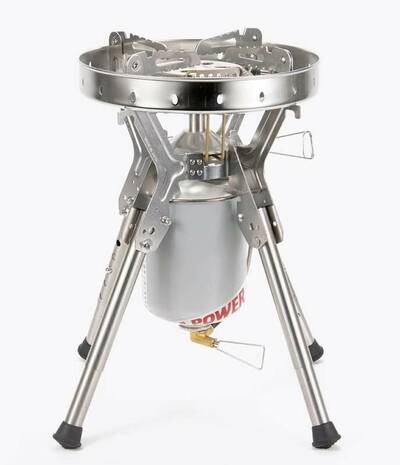
A high-end freestanding single burner, the Snow Peak Giga Power LI has a huge output.
The freestanding single burner stove is less common than the tabletop, but still prevalent enough to have a place in this guide. You might have seen one at festivals, specifically the Coleman Bottle Top Propane Stove, which is an old-school common model.
These stoves don’t require a tabletop to function and have a more vertical dimension. You can place them anywhere on the ground and cook. (Yes, you can technically do that with a tabletop stove, but you’ll literally be on the floor.
Number of People Stove Can Cook For: 1-2. A single burner is usually suitable for 1-2 people, unless you’re cooking a huge single pot of something, in which case three people is possible.
The pros and cons are very similar to the tabletop single burner, so instead of listing all those again, we’ll note the key differences:
- Uses Propane, Isobutane, or Wood: Most freestanding single burners use propane instead of butane. This makes finding fuel super easy. A few use isobutane, which is expensive but easy to find as well. If it’s a wood stove, you’ll need to likely bring in wood from an outside source, as most campsites don’t allow wood gathering. (Check your local area, of course.)
- Questionable Stability: Some freestanding stoves, like the Snow Peak GigaPower LI, are plenty stable. Others assume the screw-in canister concept of backpacking stoves, but are much larger and bulkier. This makes for a much less stable base, especially if you add a large pot to the mix.
- Not Many Models: You can find freestanding single burners if you’re really looking for them, but the market isn’t very prominent. You have one main cheap option and a couple very expensive options.
Freestanding Multi-Burner Stove
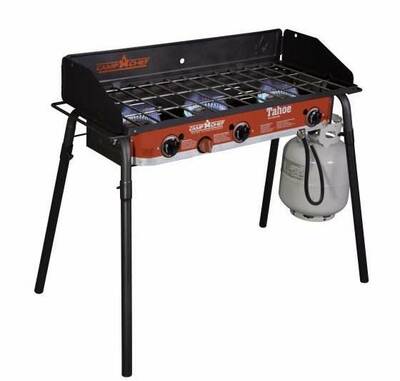
Freestanding multi-burner camping stoves, like the Camp Chef Tahoe 3 Burner Stove, are gourmet cooking machines. The Tahoe is the higher end of this kind of stove.
The final camping stove category is the freestanding multi-burner stove. This is for serious camp chefs who like a dedicated cook station, want powerful burners, and can haul huge objects.
We use the term “multi-burner” because there are freestanding stoves with two, three, and sometimes four burners in this category. Basically, companies make them in increasing sizes so the cook-happy chef can get exactly what they want.
These stoves border on tailgate stoves or even backyard barbecues, so know what you’re getting into if you decide to go the freestanding multi-burner stove route. They are less common in campsites, but if you’re the type of person who heads out for a straight week and is meeting all your friends, they may be the best bet.
Number of People Stove Can Cook For: 3-8. Depending on how many burners, these stoves have a whole group covered. Overkill for two people.
Pros
- Gourmet Status: These stoves are legit cooking platforms. The whole campground will know what kind of chef you are!
- Uses large, refillable propane tanks: Most of these stoves use the large propane tanks, which are refillable. These are one of the cheapest fuels on the market after your first purchase, and assure you won’t run out often.
- Separate Cook Area: These stoves essentially create their own cook area. You don’t need a table or anything else to cook, though using a table for prepping is a good idea.
- Powerful Burners: Typically these stoves have very powerful burners that also have great simmer control.
Cons
- Heavy: Don’t underestimate the weight. These stoves have large bodies, metal legs, and are built to be sturdy and durable. We’re talking 30-50 pounds for some of them.
- Huge: Get a big car if you plan to haul one of these stoves. Many of them collapse into themselves, but you’ll still need a chunk of space in the trunk.
- Don’t Always Have Wind Protection: It depends on the model, but sometimes these stoves are just the burners with no real protection. You can usually buy attachments for wind protection.
Camping Stove Fuel Types
The world of camping is lucky — most camp stoves use propane for fuel. This cuts down on complexity quite a bit, and makes trips to the store easy. Most of the time the camping stove you have, or plan to buy, will use propane.
For the outliers, there are a couple other options. Butane is the second most common, and is needed for most tabletop single burner stoves. Isobutane also is necessary on some high-end stoves (SnowPeak, we’re looking at you!), but that’s pretty rare.
While some stoves do technically use liquid fuel, they are rare enough that it’s not worth getting into.
See all the prominent car camping stove fuel types below.
Propane
Propane is the main fuel for camping stoves. Propane can be found readily in camping stores, hardware stores, and even some general stores or roadside stops.
There are two main form factors of propane.
16 Ounce Green Canisters
These propane canisters are well known. You screw them into the valve of most compact two burner stove systems and some single burner stove systems. They hold enough fuel for a weekend or a few days, but not much more than that.
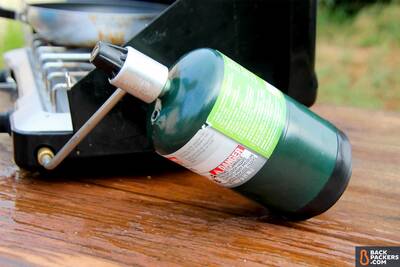
The 16 ounce green propane canister can be found in most outdoor stores. They typically attach like this, but sometimes via a hose. Simple.
One thing to keep in mind with these is that they take up room on the table. While this isn’t a huge issue for some, if your table space is very small, or if you prefer cooking without this attached, it’s worth getting the propane tank (outlined below).
Where to find: Most places won’t ship pressurized fuel without a large cost, so it’s best to go into your nearest brick and mortar outdoor store. Most camping stores and hardware stores sell these, and you can often find them at gas stations or general stores near camping areas. They are best for last minute pickups, or you can stock up on them in bulk buys.
Cost: A 16 ounce canister can usually be found for about $3. If you buy them in bulk it may be less. Propane on the whole is pretty cheap fuel.
Propane Tanks
Some frequent campers and backyard barbecuers use a five gallon tank of propane, which is often listed as a 20 pound tank. The beauty of these is that they’re refillable. This reduces the overall cost by quite a lot in the long run, and significantly cuts down on waste created by the 16 ounce canisters.
The five gallon tank is obviously much bigger and heavier than small canisters, so you’ll need room in the car to be able to haul it. More than that, though, most compact two burner stoves can’t use a five gallon tank off the bat. The valve is different, so you’ll need to buy an adaptor. All compact two burner stoves can use an adaptor, but it does increase the overall cost initially.
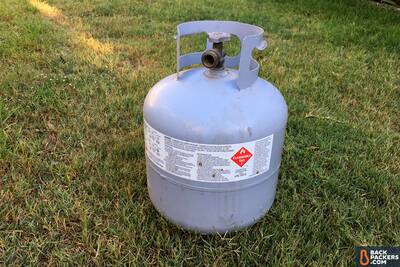
Propane tanks are a larger investment, and physically larger, but save money in the long run. You need an adaptor for most camp stoves too.
Freestanding multi-burner stoves often exclusively use a five gallon tank, much like a gas barbeque would. These usually come with the hose, so no need to buy a separate one.
The hose on the propane tank system allows the fuel to rest on the ground, with the stove either freestanding or alone on a tabletop. This frees up room for complex cooking.
Where to find: You can buy a propane tank in different sizes from any hardware store or department store. They are less common in outdoor stores like REI, but can be found readily in Big 5 or Walmart. You can select based on size, but the five gallon tanks (20 pound tanks) are the most common.
Cost: The cost of a tank ranges quite a bit depending on brand. For a five gallon tank, empty, you’re looking at a starting price of about $30, depending on your location and any local deals. Higher end brands offer more expensive tanks, which have better fuel gauges and regulators. These will run anywhere from $45 and up, depending on size.
The cost of filling up one of these tanks is dependent on the market, but usually runs around $3.50 per gallon, so roughly $18 per five gallon tank. A single 16 ounce canister is usually $3 alone, and 8 of them make up a gallon. In the long run a propane tank is a much more cost efficient method, so get one if you’re serious about camp cooking.
Butane

Butane canisters are hard enough to find that we didn’t go through the hassle. This is what they look like when wrapped in plastic.
Butane is a less common fuel for camping, but it has its place. Butane often comes in small eight ounce canisters, in a tube shape, which fits directly into a tabletop single burner stove. While these are handy and take up less space than either propane method, they are increasingly hard to find. You can buy an adaptor hose to convert butane to propane tanks, but it’s more of a hassle than it’s worth.
The main drawback of butane over propane is that butane doesn’t at all work in freezing conditions, and works poorly at altitude.
Where to Buy: Small butane canisters are pressurized, so we don’t recommend getting them shipped. You can find them in some outdoor stores like Big 5 and Walmart, but you need to check to see if they are in stock. Butane is increasingly hard to find.
Cost: An eight ounce canister of butane typically costs around $3, but in some places you can find them for $1.50. You can buy them in bulk to reduce costs as well. Given their size, this is not any cheaper than propane canisters, and much more expensive than a refillable propane tank.
Isobutane
Isobutane is the most common fuel for backpacking stoves, but some very specific camping stoves, like the SnowPeak GigaPower LI, use these canisters. They typically come in four, eight, and 16 ounce canisters, and are the most expensive fuel you can commonly find.
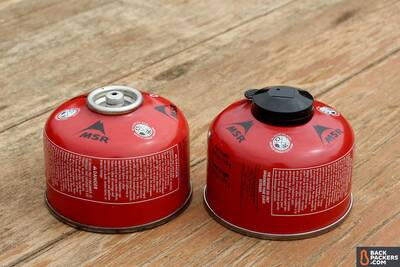
Where to Buy: This fuel is pressurized, so we don’t recommend getting it shipped to you. You can find isobutane canisters in most major outdoor stores, like REI or Big 5, and should grab the size that works best for your camping situation.
Cost: The largest isobutane canister you can buy is 16 ounces, and that’ll cost you roughly $10, depending on the brand. That’s more than twice the cost of a 16 ounce canister of propane.
Stove and Fuel Efficiency
Stove and fuel efficiency matters a lot for the backpacking crowd, where weight and number of days in the wilderness are critical to how much fuel you take.
For car camping, it has no real dire consequences. Or, almost none. We can’t discount those of you who camp on BLM land for weeks, miles and miles from civilization! But for most car campers fuel is a short drive away, and there’s no issue with bringing extra because your car can probably handle it.
That said, a stove that burns through fuel like a jet engine is a major bummer, and will cost you in the long run. You’ll want a stove that uses common fuel, doesn’t guzzle it, and yet retains powerful output so you can cook quickly and efficiently.
With that said, there are a number of factors that go into stove and fuel efficiency. Know that there’s no “perfect” solution. There are too many variables to nail it down specifically. You have to consider altitude, temperature, wind, the stove type and specific model, the fuel type, and the meal you’re trying to cook (water or real food), to name a few.
We’ll break down verified specifics about efficiency below.
Stove Output: What Are BTUs?
The main consideration in efficiency, burn time, and stove power is the BTU, or British Thermal Unit. The British Thermal Unit “is a traditional unit of heat…defined as the amount of heat required to raise the temperature of one pound of water by one degree Fahrenheit.
You’ll find a BTU output listed on most stoves in the U.S. and can use this as a rule of thumb for how powerful they are going to be. (You may also see “W”, or Watt hours, another unit of power and heat. We’ll stick to BTUs as they are more common.)
To be clear, stove power, whether it’s BTUs or Watts, should really be written with a “per hour” demarcation, just like your car has Miles Per Hour. But most consumers don’t assign a real value to the BTU number, so it gets left out of marketing materials.
Generally speaking, the higher the BTU/hr the more powerful the stove is. More power means faster boiling times and greater consumption of fuel.
Except, not always. The design of the stove has a lot to do with how that BTU/hr power is channeled, so some stoves with a very high BTU/hr number but poor design boil less quickly than those with a lower BTU/hr and excellent design.
This is mostly determined through trial and error across the camping and backpacking world.
For camping stoves, you should get a number for each burner. Around 10,000 BTU/hr per burner is the standard baseline for most outdoor stoves. The stove types and burners are broken down as follows:
Tabletop Single Burner: This burner usually has an output of 8,000 BTU/hr. This number isn’t overwhelming strong, but it will cook food just fine, and boil a liter of water in around 5 minutes.
Freestanding Single Burner: This stove type varies wildly for output. Basic models output around 10,000 BTU/hr, while high-end versions (SnowPeak) output 34,000 BTU/hr. Get one that fits with your needs.
Compact Double Burner: These burners can range from 10,000 BTU/hr to 20,000 BTU/he each, give or take. The higher-end stoves have more powerful burners, can boil water more quickly, and have better simmer control.
Freestanding Multi-Burner: While the number for these burners can get really high, most of the freestanding multi-burner stoves specifically for car camping output 30,000 BTU/hr per burner. They are meant for gourmet chefs.
Boil Time
Boil Time is of the utmost importance for backpackers, but for car campers it’s not critical. Most people are having a mellow morning or evening, and cooking a meal is going to take longer than boiling a pot of water.
The boil time depends on the pot you’re using, the current temperature, and the wind, but as a general rule of thumb car camping stoves can boil a liter of water in 2-5 minutes.
Wind resistance
Wind is the quickest killer of fire. If your stove is not protected on a windy night the flame will go out — it’s as simple as that. Car camping stoves have large burners and a sturdy flame, but can still be snuffed out by a strong gust. Mostly, though, the wind will reduce the consistency of the flame, and you won’t be able to cook the way you want to.
We recommend getting a camping stove with built-in wind protectors. Compact two burners are the best at this because of their form factor. Their lids open up and provide a full wind block from the back, and most have side panels that snap in to create protection on three sides.
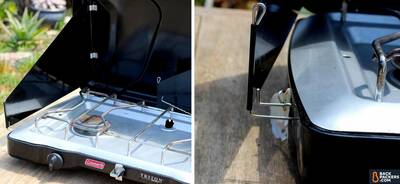
Most compact double burners and freestanding multi-burner stoves have a windscreen on three sides. The compact double burners work as this image shows, with side-screens that fold up when not in use, then click into a port when it’s windy.
That’s about as good as it gets. If it’s really windy you could use a tub lid or some other wind blocker while you cook, but having one side open is almost always required.
Large freestanding stoves often come with panels that create wind blocks as well.
Camping Stove Features
A stove without features is pretty boring! We’ve covered a number of features indirectly above, but it’s time to get into more of the specific functions of car camping stoves and how they will help you cook the meal of your dreams.
Simmering
Simmering is probably the most sought after aspect of a good car camping stove. Boiling water uses the full power of a burner, but most meals aren’t cooked on high. If you want Mac n’ Cheese, bolognese pasta, or risotto you’ll need a simmer.
On a camping stove, much like your stove at home, this basically asks the question: how low can your stove go? You want the flame to get tiny without shutting off.
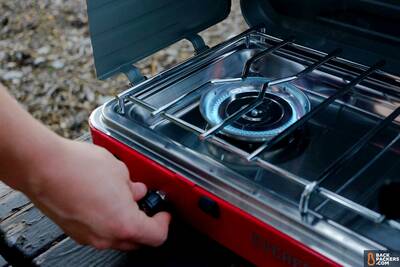
The higher-end stoves, like the Camp Chef Everest, simmer extremely well. Others are just average. The worst of them go from off to maximum flame with a small twist.
Everyone has slightly different ideas of what a “good” simmer is, and this can vary quite a bit in the camping stove world. We tend to base it on onions. When you put onions and a bit of oil on your pot or pan, can they get glassy and clear, or do they turn brown? When you add sauce to that, does it boil up immediately, or can you first warm it, then get it hot, then bring it to a boil?
If you can get clear onions and a warm sauce, your stove can simmer.
The good news is that all camping stoves models can be good simmer-ers. The burners are large and the knobs can engineered for precise flame control. The bad news is that this means each stove model has to be tested individually to determine just how good it is. We try and highlight stoves that are great for simmering, because we think cooking is a huge part of the camping experience.
What is Piezo Ignition?
The best way to impress new campers is to have and use a stove with Piezo ignition. With a single click you magically light your stove — one press and BAM, fire. It’s fancy and fun, but what is Piezo ignition?
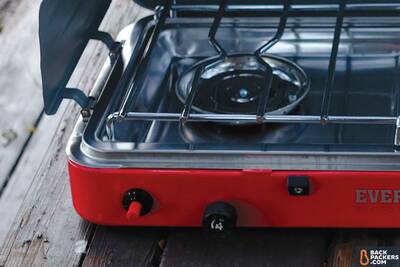
The red button on the Camp Chef Everest (and many other stoves) is the Piezo ignition. Turn the valve to low, then click the button. Fire!
We’ll quote a reputable source here, as nobody on the team is a scientist:
“Piezo ignition uses the principle of piezoelectricity…the electric charge that accumulates in some materials in response to high pressure. It consists of a small, spring-loaded hammer which, when a button is pressed, hits a crystal of PZT or quartz crystal. Quartz is piezoelectric, which means that it creates a voltage when deformed. This sudden forceful deformation produces a high voltage and subsequent electrical discharge, which ignites the gas.”
So when you open the valve on a stove and click the auto-magic button, you’re hitting a piece of quartz crystal to create an electrical discharge. Fancy.
The Issue with Piezo Ignition
Some people love the simplicity of Piezo stoves. You don’t have to rummage around for a lighter or match, and the stove is even more of a self-contained unit. However, Piezo ignition has a few downfalls:
- Cold and Altitude: Piezo ignition works great at low elevation in three-seasons. But the second you try to ignite a stove in winter above 10,000 feet, you may not see the spark of flame you’re looking for. This is a known issue and many campers use the backup fire starter (matches or lighter) to thwart the issue.
- Breaks over time: This is highly dependent on the manufacturer, and even on the individual stove, but these Piezo buttons can fail over time. It’s a moving part that relies on a small hammer to hit a crystal, and small parts tend to fail after a certain number of uses. Once your stove has a defunct Piezo ignition, there’s not much you can do. The stove still works, but you have to light it like normal.
- Added Cost: You might see a stove that is offered in “manual” and “auto” versions. The manual you have to light the old fashioned way, the auto with a Piezo. Typically manufacturers tack an additional $10-$20 onto the auto stove.
If you like the convenience of a Piezo ignition stove, get one. It’s worth it for a lot of people, and definitely adds to the “deluxe” idea of a campout.
Griddles and Grills
Cooking with pots and pans is one thing, but using a griddle and/or grill on a camping stove is something most people will want to try at some point. There’s that idyllic image of frying up some flapjacks and bacon on your griddle, which fits seamlessly on your camp stove. It really can be that sweet.
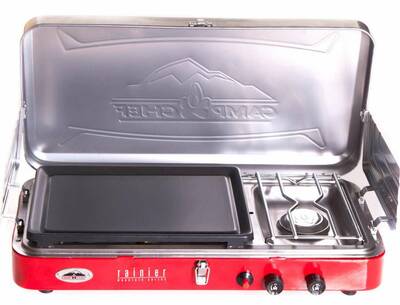
The stove set by Camp Chef comes with the griddle. While it’s convenient, we recommend buying the griddle separately for a high quality cook.
To be clear, a griddle is a long flat surface that cooks eggs, pancakes, crepes, and other “flat” things. A grill is a ridged surface meant for cooking meat, veggies, and fish.
There are a handful of stove companies, like Coleman or Camp Chef, that make stoves and griddles. If you want to get a “perfect” fitting grill or griddle for your stove, make sure to get the stove and the grill/griddle from that company.
However, you can also buy a griddle from a company like Coghlans, which produces cookware separately. As long as you match the dimensions reasonably well, the accessory should work well.
A few things to look for:
- Cast Iron: Cast iron is the primary material for griddles and grills. They cook food well, are fairly easy to clean, and will last pretty much forever. Your pots and pans don’t need to be made of cast iron, but we recommend your griddle to be. That said, not all cast iron is made equally. Get a quality one.
- Reversible: A few companies make a griddle/grill combo. One side is flat for pancakes and eggs, the other has ridges for steaks and fajitas. We like the versatility of this. You’ll probably use the griddle in the morning and the grill at night.
- Handles: It may seem like a no-brainer, but it’s worth mentioning that handles on a griddle/grill are very useful. You need to be able to pick it up, even when it’s hot, and these help a lot.
- Length: Some griddles/grills will cover the entire length of your stove. This allows for a full feast of whatever deliciousness you’re cooking up. However, it means you can’t use a pot at the same time. If you want to cook a delectable sauce while grilling your fresh fish, you’ll need a grill that is only half the length of your stove, so one burner stays open. Consider this before purchase.
Propane Adaptor Hose
As we mentioned in the propane section, most compact stoves can use a propane tank instead of a canister if you buy an adaptor hose. This will save a lot of money in the long run, so if you camp regularly it’s probably worth it.
There are a couple considerations when it comes to these hoses:
- Length: Most hoses are five feet long, but you can get them longer. We recommend at least five feet so the hose can go from a table to the ground easily, which is where your tank will likely sit.
- Ease of Use: You’d think all hoses are made the same, but they’re not. Different brands have different knob sizes for screwing on and off, and the ones with larger plastic grips are best. It makes this process quick and painless.
Choosing the Camping Stove That’s Right For You
With the heap of information above, we hope you can select the best camping stove for you. In the end, you’ll be eating pancakes and drinking a hot cup of coffee in the wild, so you’re in good company.
Affiliate Policy: We support the hours that go into our guides and reviews through affiliate commissions on purchases made through links in this article. Please help support us to create content like this!
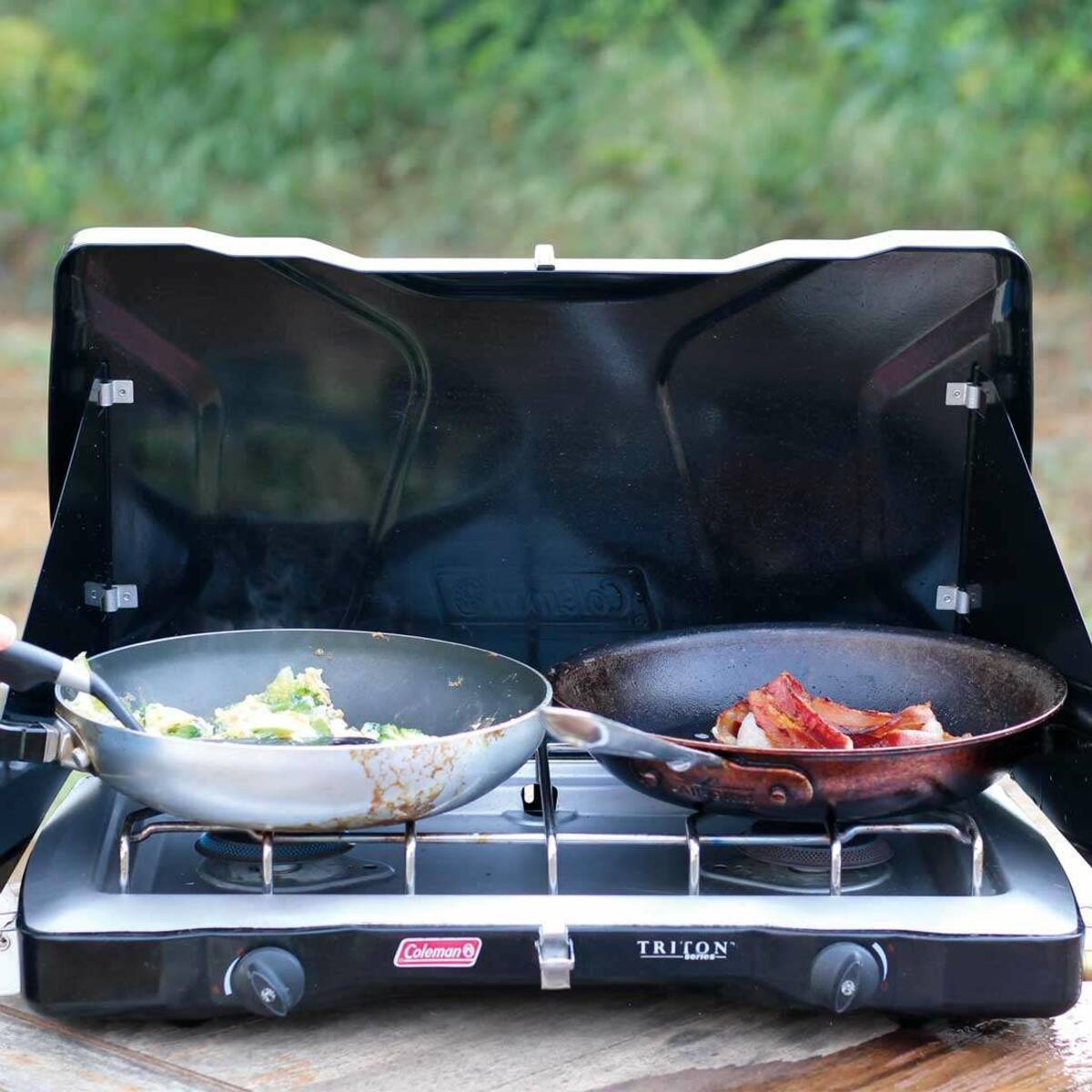
I am in a confusion of choosing among the different types of camping stoves. You explained everything in detail that helped me to choose the best camping stove.
You missed a really serious con for Tabletop Single Burner Stoves. Those Butane canisters are worthless if the temp drops below about 40 degrees. They are super convenient when its warm and sunny, but simply fail to function when it starts getting cold out.
I tried using one a few weeks ago at a group camping trip, and while I knew this might be an issue, I was surprised that at 30 degrees, I couldn’t even light the thing.
Fortunately, I had my trusty old Pocket rocket and a four season isobutane mix, so the omelets where saved.
While you can cook on a campfire, having the right tools to ensure you get the job done right can make all the difference between a tedious chore and an enjoyable activity.
There is a mistake here: “To be clear, stove power, whether it’s BTUs or Watts, should really be written with a “per hour” demarcation”
It is true for BTU, that is an energy unit so power should be expressed as BTU/time. But Watt is a power unit, Jules/second. Therefore it should not be written as “per hour”. One more point for team SI against the outdated British system of units.